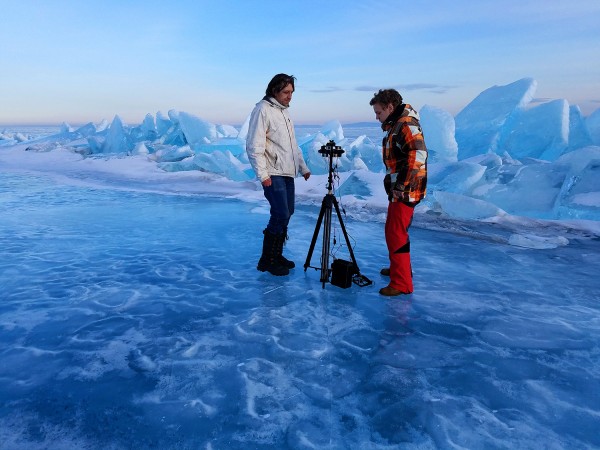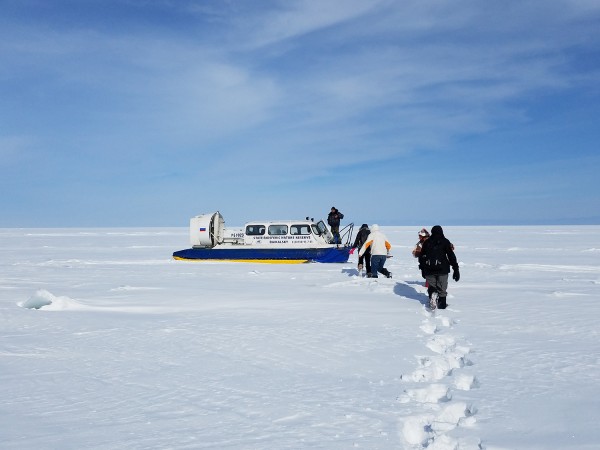Google Expeditions shoots VR film in Siberia
Google Expeditions, a programme that provides children with virtual reality school trips, have filmed their latest segment at Lake Baikal in Siberia, Russia. Previous films within the programme include scenes from along the River Thames, the top of the Burj Khalifa and inside Jiuzhaigou National Park to name a few.
 Lake Baikal is rarely visited by productions and so we spoke to Michael Owen, Producer and Co-Director of the project and the one who presented the idea to Google, to understand the process involved.
Lake Baikal is rarely visited by productions and so we spoke to Michael Owen, Producer and Co-Director of the project and the one who presented the idea to Google, to understand the process involved.
How does Lake Baikal compare to other locations you’ve worked with and what does it offer?
Lake Baikal is a unique place. Among other things, it’s the oldest, deepest and the most voluminous body of liquid fresh water on planet earth. It is a UNESCO World Heritage site. It’s also remote and on the opposite side of the globe from New York, 12 time zones away. Find Ulaanbaatar, the capital of Mongolia on a map, then look North 250 miles and you will find Lake Baikal in Southern Siberia. Because it’s so remote it’s also the Galapagos of fresh water ecosystems, with thousands of indigenous species of flora and fauna. Many areas around the Lake are Russian national parks.
In terms of production, the issues are similar to shooting in remote areas or National Parks like Big Bend, Glacier or Yellowstone in the US. You have to bring all your equipment and supplies with you. There is no local technical production support. My crew and equipment came from Moscow which is a seven-hour flight, crosses five time-zones to either Irkutsk or Ulan Ude. In terms of support for transport and accommodation there are quite a few guide services and outfitters who can assist media productions.
Lake Baikal and the region are obvious subjects for documentaries. There have been a lot over the years. The attraction for narrative or commercial production is the spectacular landscapes.
My interest is in the scientific and cultural stories, but we wanted to shoot in March because the Lake was still frozen solid and we could travel on the surface. It's snow covered in some areas and windswept ice in others. As the ice expands and contracts depending on the temperature, sections of ice crash into each other creating these incredible ridges of broken ice out in the middle of the lake.
I’ve never seen anything like it before. The still 3D panoramas we delivered to Google Expeditions are really amazing. I’m still working on a short VR video with the live action sequences we shot.
 Can you talk about the VR technology that was used on the shoot?
Can you talk about the VR technology that was used on the shoot?
The camera system we used is a custom, 11-GoPro camera 3D 360° spherical rig developed by GigaPano, the Moscow based company that provided the camera and DP and AC.
What are the logistics like in terms of nearby Production Services?
Any and all camera, grip or lighting equipment will have to be brought in. There are outfitters who normally support scientific groups, trekkers and divers who can help with transport, food and accommodation as well as art department. Travel by boat or hovercraft in winter is essential to get around.
What were the major technical challenges that you have to overcome during production?
Shooting VR, the camera crew usually hides when the camera is rolling so as not to appear in the shot. However, when you are hiding behind a rock or a building it’s impossible to see what the cameras are recording. For example we left the camera between the stalls of a fish market. I wanted to capture a transaction between a customer and fishmonger that was close to the camera but also not at a moment when someone passed by close to the camera, ruining the shot. We used a Ricoh Theta 360 camera attached to the tripod as a crude video assist source for us to observe on an iPhone or iPad what was happening around the camera. The Theta worked when the area was in range of our WiFi hot spot.
Related Posts
- Mercedes-Benz and Mitsubishi film separate ad spots on location on frozen Canadian lakes
- Partizan travels from Mexico to Alaska for Honda and films with a 360-degree camera
- Filming on location in Jackson Hole with Location Manager Ian Gersten
- Filming in Bolivia with the Benavides family
- Hyundai brings art to the wilderness filming on location in Western Australia
- Uganda: a fast growing, prime location for film productions
- TLG talks to Location Manager Carl Wood
- Location Report: Filming on location in Tanzania in East Africa
Related posts:
Global Filming Incentive - Russia (see more…)
Comments
Not Logged in
You must be logged in to post a comment
There are no comments